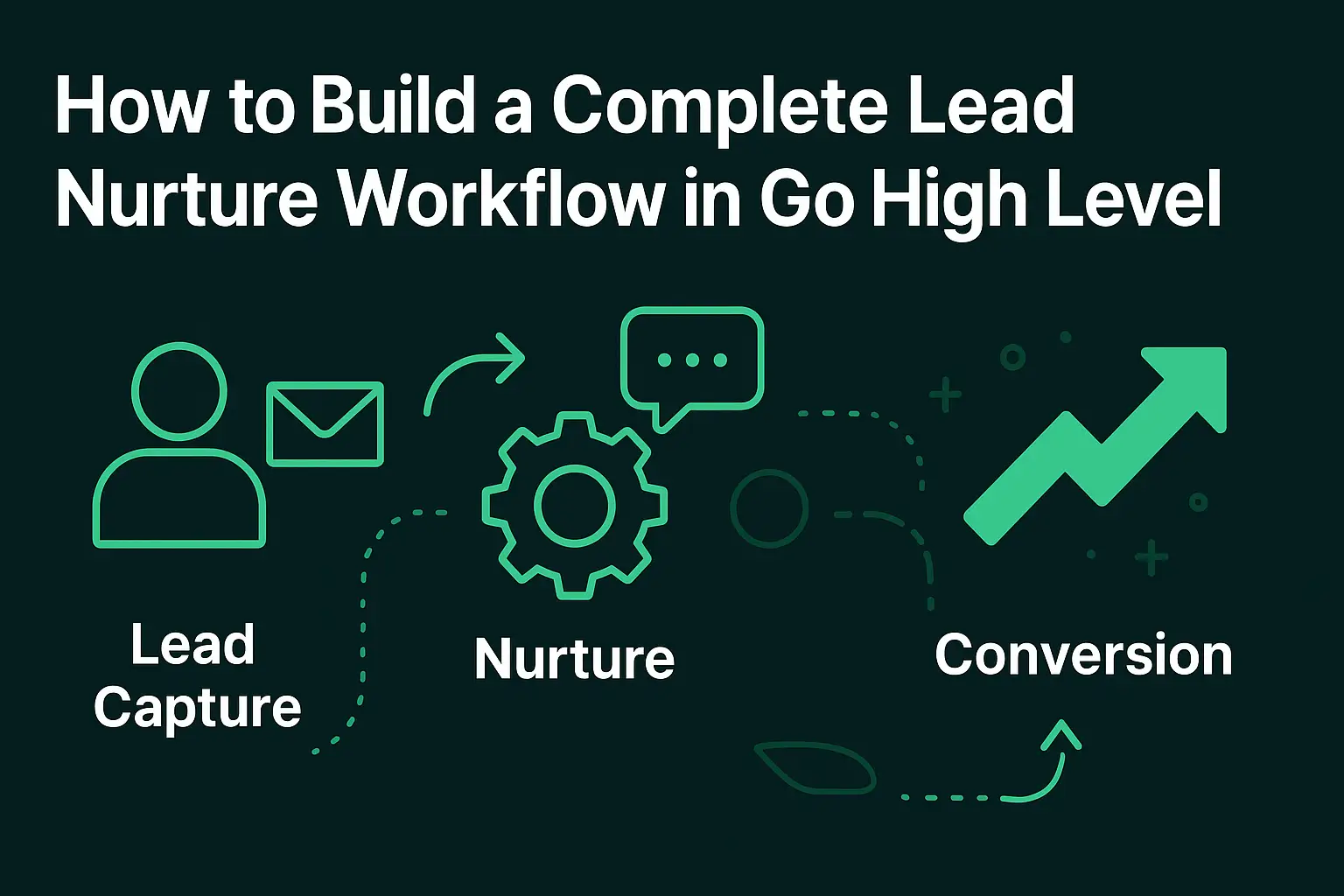How to Build a Complete Lead Nurture Workflow in Go High Level (Step-by-Step Guide)

How to Build a Complete Lead Nurture Workflow in Go High Level (Step-by-Step Guide)
A practical, step-by-step walkthrough for small business owners and coaches who want to convert more leads using Go High Level automation, nurturing sequences, and strategic integrations.
Lead nurturing is the difference between a website visitor and a paying client. A well-built Go High Level lead nurture workflow converts casual prospects into engaged buyers by delivering the right message at the right time — automatically. This guide walks you through a complete, battle-tested workflow you can deploy in Go High Level today, plus an advanced subtopic on integrating external systems (webhooks & APIs) to extend your automation power.
Why a Lead Nurture Workflow Matters
For small business owners and coaches, every lead is precious. Most visitors aren’t ready to buy on their first visit — they need follow up, education, and trust signals. A Go High Level lead nurture workflow maintains consistent communication, increases conversions, and saves you hours of manual follow-up. When designed with psychological triggers (reciprocity, social proof, urgency), a nurture workflow becomes a revenue engine that works 24/7.
Overview — The Complete Lead Nurture Workflow (High Level)
Before we dive into step-by-step instructions, here’s the full workflow you’ll build in Go High Level:
Step 1 — Create Reliable Lead Capture Points
Every nurture workflow begins with capturing a lead. In Go High Level you can create forms, surveys, and high-converting landing pages — or embed GHL forms on your website. For best results:
- Use a single primary CTA per landing page to reduce friction.
- Ask only for essential data (name, email, phone) at first — you can collect more later.
- Use tracking parameters (UTM) to identify traffic sources for better segmentation.
Learn more about GHL forms and funnels on GoHighLevel’s docs: GoHighLevel Help.
Step 2 — Immediate Acknowledgement: Speed-to-Lead
Speed-to-lead matters. The first follow-up determines whether a lead stays engaged. Use Go High Level to send:
- Instant SMS (short, personalized)
- Instant email (thank you + next step)
Template example (SMS): “Hi {firstName}, thanks for your interest — I’ll send a quick next step by email. Book a time if you’re ready: {booking_link}.” Automate this in GHL with a simple workflow trigger on form submission.
Step 3 — Tagging & Lead Scoring (Segment to Convert)
Tagging and scoring allow your nurture workflow to be personal and relevant. In GHL:
- Create tags like
lead-source:facebook,interest:coaching,lead-score:5. - Set rules to increment lead score when they click, open, or visit key pages.
- Use tags to route high-intent leads directly to a sales pipeline stage.
Segmentation is where many funnels fail: treat people differently based on actions — that’s personalization at scale.
Step 4 — Build the Nurture Sequence (Email + SMS Mix)
Your nurture sequence should educate, build trust, and invite micro-commitments. A balanced sequence for coaches/small businesses looks like this:
- Day 0: Welcome email + instant SMS (deliver lead magnet or confirmation)
- Day 2: Story-based email (social proof + case study)
- Day 5: Value email (tips, quick wins)
- Day 8: Invitation to a low-friction offer (free audit, discovery call)
- Day 12: Reminder + urgency (limited slots)
- Ongoing: Monthly value newsletter + retargeting ads
Implement these in GHL using the Campaigns (Sequences) feature. For deliverability best practices, review HubSpot’s guide on email deliverability: HubSpot Email Deliverability.
Step 5 — Engagement Triggers & Conditional Paths
Use conditional logic to move leads down different paths based on actions:
- If a lead opens & clicks — accelerate outreach (move to Sales Pipeline)
- If a lead doesn’t engage — resurface with different content or segment to long-term nurture
- If a lead books a call — cancel remaining sequence and start onboarding automation
Go High Level workflows allow you to set these conditions visually — no code needed for most cases.
Step 6 — Qualification & Moving to Pipeline
When a lead meets your qualification criteria (score threshold or booking), automate:
- Move to a “Qualified” pipeline stage
- Create a task for a sales rep or you to call
- Send a calendar booking confirmation + reminders
This keeps your team focused on high-value activities while automation handles the rest.
Step 7 — Automated Reminders, Bookings & Reducing No-Shows
Use GHL’s calendar integrations to send multi-touch reminders (email + SMS) at 24 hours and 1 hour before a call. Add pre-call forms—this increases call preparedness and reduces no-shows dramatically.
Step 8 — Post-Conversion Onboarding
Conversion isn’t the end — it’s the start of a relationship. Trigger an onboarding sequence that delivers:
- Welcome kit and next steps
- Billing & contract links
- Intro call scheduling
- Access to client resources or portal
Automating onboarding improves retention and sets the tone for great service.
Advanced Subtopic: Integrating External Tools (Webhooks, APIs & Zapier)
While Go High Level covers most workflow needs, integrating external tools expands capability. Use webhooks and APIs to sync Shopify orders, payment gateways, or custom CRMs. Common patterns:
- Webhook → Queue → Worker: Receive Shopify order webhook → enqueue job → upsert contact into GHL via API.
- Zapier / Make: Quick glue integrations for SaaS tools (Zapier tutorial here).
- Custom API calls: For advanced personalization, call your backend to compute lead value, then tag in GHL.
Example GHL API call to upsert a contact (simplified):
For more technical detail, see GoHighLevel’s API docs: GHL Developers. If you're not technical, tools like Zapier or Make will do the heavy lifting with visual builders.
Testing, QA & Deliverability
Testing is crucial. Steps to validate your Go High Level lead nurture workflow:
- Test form submissions across devices
- Verify email deliverability and authentication (SPF, DKIM, DMARC)
- Use internal test tags to ensure conditional paths trigger correctly
- Monitor campaign metrics (open, click, conversion rates) and tweak
Neil Patel’s articles are a great source for CRO and testing ideas: Neil Patel Blog.
Measurement: KPIs to Track
Track these KPIs to know how your nurture workflow performs:
- Lead-to-call conversion rate
- Sequence open & click-through rates
- Lead velocity (time from capture → qualified)
- Cost per acquisition (CPA)
- Customer lifetime value (LTV) uplift from nurture
Quick Troubleshooting Checklist
- No emails sending? Check SMTP settings and GHL deliverability.
- Leads not being tagged? Verify workflow triggers and tag rules.
- Too many unsubscribes? Audit content frequency and message relevance.
Ready to implement a high-performing Go High Level lead nurture workflow without the guesswork?
🚀 Get a Custom Automation Plan
